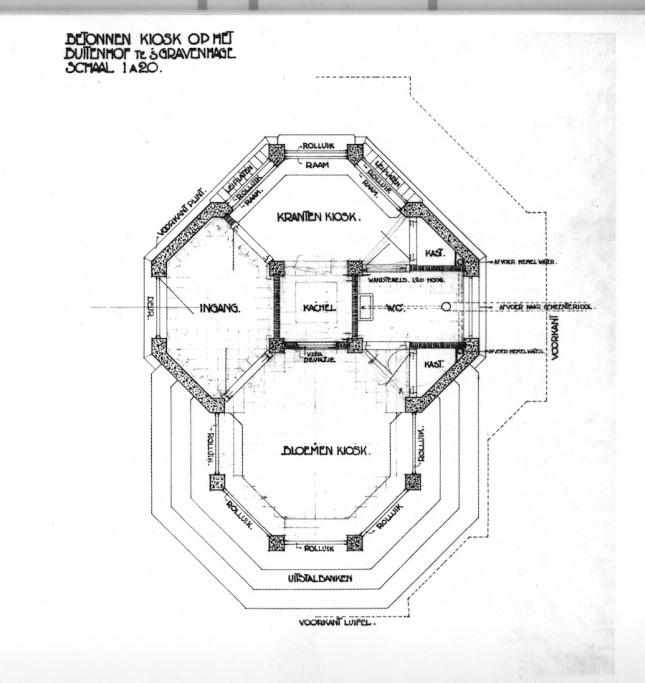Berlage’s kiosk, a glorified Cubo-Expressionist structure of the humble building type, was realized by the Dutch architect in 1925. Sited in the Buitenhof, a large plaza set just before the Dutch government complex in The Hague, it deserves attention because of its original design as well as for being in the crux of a timely urban plan. It is named after H.P. Berlage (1856-1934), a giant in Dutch architectural and urban history, who designed many recognized national monuments.
This kiosk offers the visitor an ingenious directional line of sight from an axis at the rear of its two intertwined octagons in plan, through its front door and straight through two rows of newly planted deciduous trees to the pinched gateway and finally to the government center at the Binnenhof. Hendrik Berlage, who is known for his extension of Amsterdam-South (1903-1915), also designed and radically modernized the Buitenhof, a democratic government complex. In its beginnings, the Buitenhof was a lazy, mostly medieval part of town, which he transformed into a modern, 20th century space for commerce, communication and speed. It was once a road and parking lot for automobiles but now, they are forbidden and bicycles are have taken over the space. Moreover, the Publieke Werken department has inserted cumbersome racks for the bikes in the Buitenhof and these crowd the area near the kiosk.

The kiosk alone is historically significant as Berlage’s use of materials came from the German, Gottfried Semper (1803-79), who taught Berlage and whose buildings and theories still hold a lot of value. Berlage’s use of a reinforced concrete weight-bearing frame structure with stone or brick enveloping curtain wall are included in Kenneth Frampton’s, Studies in Tectonic Culture (1995) where it is depicted as a flower kiosk with expressive and logical use of materials. Frampton also noted that this expression of structure and fill came likewise in the early, large-scale Berlage monument of the Stock Exchange in Amsterdam (1899-1903).
Kiosks as a building type gained in number during the past two centuries due to the easy availability of iron and glass materials and the rise in importance of daily newspapers and frequent journals. However, Berlage’s kiosk functions varied and in fairly quick succession it became an art supply venue to an information company (the VVV), until finally settling on a food service concern. Over the years its form also changed, from a trim, stepped profile to a bulbous midway shape with cabinet like windows serving food and drinks to the surrounding tables and chairs.

Prototypes for the kiosk’s formal qualities lay in Renaissance and contemporary sources. One can think of it in the tradition of quatrocentro and cinquecento design, namely being free-standing and centralized with pronounced cupola and steps at the base, like Bramante’s Tempietto (1504). However, the kiosk is more open, although axially directional in space, and the Tempietto is placed in an enclosed, staged environment.
Expressionist and cubistic referents come in the rough concrete surfaces, like Richardson or the later Brutalists, and the hovering horizontal beam-like extensions are in the tradition of De Stijl.
The cupola or lantern has become the bellwether of the building’s history: Recently, it was painted white, replacing its original gray, but the public protested and, consequently, it was redone in gray. On the controversy of the kiosk’s fate, it would be a fitting lesson for the Publieke Werken to rethink the bicycle racks and move them in another part of the Buitenhof so that they would have room to breathe.








